大洋板塊俯沖帶地震波各向異性及剪切波分裂的成因機制
孫圣思,嵇少丞,2
(1.加拿大蒙特利爾大學工學院民用、地質、采礦工程系,蒙特利爾H3C 3A7;2.中國地質科學院地質研究所,國土資源部大陸動力學重點實驗室,北京100037)
大洋板塊俯沖帶地震波各向異性及剪切波分裂的成因機制
孫圣思1,嵇少丞1,2
(1.加拿大蒙特利爾大學工學院民用、地質、采礦工程系,蒙特利爾H3C 3A7;2.中國地質科學院地質研究所,國土資源部大陸動力學重點實驗室,北京100037)
大洋板塊俯沖帶是許多重要地質作用(例如脫水、部分熔融、巖漿和地震活動)發生的場所。對位于俯沖帶之上的地震臺站所檢測到的不同剪切波的數據解析,可以獲得源于上覆板塊、地幔楔、俯沖板塊和板下地幔的地震波各向異性的關鍵信息。本文系統總結了世界各地大洋俯沖帶的剪切波分裂樣式,對目前國際上流行的大洋俯沖帶的地震波各向異性的主要成因模式(例如地幔楔拐角流、與海溝遷移有關的平行海溝的地幔流、橄欖石位錯蠕變形成各類組構以及蛇紋石化的影響等)進行了較為詳盡地評述。由橄欖石(010)[100]、(010)[001]、(100)[001]、{0kl}[100]、(001)[100]和{110}[001]位錯蠕變形成的晶格優選定向(LPO)分別稱之為 A 型、B 型、C 型、D型、E型和F型組構,其中A型、D型和E型組構總是導致剪切快波的偏振方向(φ)平行于地幔流的方向,而B型組構則導致φ垂直于地幔流的方向。C型組構雖然也能使φ平行于地幔流方向,但快慢波之間的延遲時間(δt)則不如同等條件下A型組構形成的那么大。F型組構導致剪切波在垂直于地幔流動面的方向上傳播時幾乎不發生分裂。葉蛇紋石是俯沖板塊地幔和地幔楔中最主要的含水礦物,具極低的流變強度、很低的地震波速和很大的彈性各向異性。蛇紋石化程度越高,變形地幔巖的各向異性就越大,則弧前地幔楔的剪切波分裂愈強。只要蛇紋石的含量超過10%~20%,則變形地幔巖的地震波各向異性特征將由蛇紋石的LPO主導。地幔楔的剪切波分裂特征主要取決于其蛇紋石化程度與俯沖角度,陡傾的俯沖和高程度的蛇紋石化有利于形成平行于海溝的φ。
大洋俯沖帶;地震波各向異性;剪切波分裂;橄欖石組構;海溝遷移;蛇紋巖化;地幔楔
0 引 言
在各向異性介質中傳播的剪切波(S波)會分裂成兩個偏振方向相互垂直、速度不同的子波,速度快的是快波(Vs1),速度慢的是慢波(Vs2),兩者之間的走時差或稱延遲時間(δt)是剪切波穿越途徑上介質的彈性各向異性的度量。快波的偏振方向(φ)平行于該介質中與剪切波傳播方向垂直的面上的速度最快的方向,與有限應變橢球主軸(X,Y,Z)或主切面(例如構造線理和面理或剪切面)方位具一定的幾何關系。φ和δt是目前量化地殼和上地幔剪切波各向異性的兩個重要參數。
板塊俯沖帶不僅是地球上構造活動極為活躍的地區,而且是相變、脫水、部分熔融、巖漿作用和地震活動的重要場所,因而理所當然地成為剪切波分裂研究的重要對象。通過分析俯沖帶之上地震臺站所檢測到的不同剪切波數據可以區分各向異性的來源:上覆板塊、地幔楔、俯沖板塊或俯沖板塊之下的地幔(圖1)。
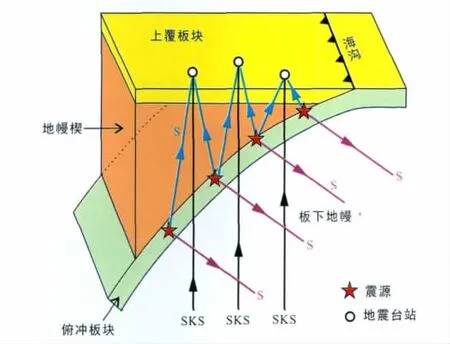
圖1 S波和SKS波的傳播路徑及其所反映的地震波速各向異性的源區(上覆板塊、地幔楔、俯沖板塊、板下地幔)Fig.1 Illustration of various raypaths of S and SKS waves that detect seismic anisotropy contributed by different parts of subduction system(i.e.,the overriding plate,the mantle wedge,the subducting slab,and the subwedge mantle)
(1)由震源位于俯沖板塊的地震所產生的S波,經地幔楔直接傳到上覆板塊上的地震臺站,主要記錄了地幔楔的各向異性(Fischer and Wiens,1996;Fischer et al.,2000;Levin et al.,2004;Long and van der Hilst,2006;Pozgay et al.,2007;Abt et al.,2009),因為一般來說地殼對S波分裂的貢獻很小 (Ji and Salisbury,1993;McNamara et al.,1994;Herquel et al.,1995;Sherrington et al.,2004;Frederiksen et al.,2003;Ozacar and Zandt,2004)。例如,新西蘭Alpine右旋走滑斷裂經過地區的地殼的S波分裂δt≤0.1 s,雖然實驗室內測定采自該斷裂帶的構造片巖和糜棱巖的地震波速各向異性高達 17%(Okaya et al.,1995;Godfrey et al.,2000),上述差異很可能是由于測量的尺度效應造成的,在天然S波穿越范圍(直徑約40 km的圓柱體)內,多期多階段的變形相互疊加形成極其復雜的構造樣式,不同方向的各向異性彼此消減,甚至抵消(Ji and Salisbury,1993;Ji et al.,1994;Pulford et al.,2003)。
(2)由震源位于俯沖板塊的地震所產生并向板下地幔傳播的S波,被遠處的地震臺站記錄,其數據經過分析校正后可以得出地幔楔以下,即俯沖板塊和板下地幔的各向異性(Russo and Silver,1994;Russo,2009)。
(3)由俯沖帶之上地震臺站記錄到的遠震SKS或SKKS分裂,反映其近垂直傳播路徑上所有各向異性層的綜合信息,減去地幔楔的貢獻就可得出俯沖板塊及其板下地幔的各向異性信息(Abt et al.,2010)。
1 大洋俯沖帶剪切波分裂的樣式
20世紀下葉,Ando et al.(1983),Fukao(1984),Bowman and Ando(1987)等率先發表了日本列島和湯加地區的俯沖帶剪切波分裂的數據。此后,地震學家分別對全球幾十個俯沖帶開展了地震波各向異性的研究。Long and Silver(2008,2009)綜合總結了全球15個俯沖帶剪切波分裂的特征(圖2)。該圖中藍色和紅色雙箭頭分別代表φMW和φSW方向,φ代表剪切快波的偏振方向,其下標MW和SW分別代表地幔楔(Mantle Wedge)和地幔楔以下的俯沖板塊及其板下地幔(Subwedge)。
地幔楔以下的剪切波分裂特征較為簡單。φSW大多平行海溝,例如太平洋北側的阿留申列島(Long and Silver,2008)、西北側的勘察加半島-千島群島(Peyton et al.,2001;Levin et al.,2004)、臺灣以東的琉球群島(Long and van der Hilst,2005,2006)、伊豆 -小笠原 -馬里亞納群島(Wirth and Long,2010;Wookey et al.,2005)、湯加 -克馬德克-新西蘭列島(Long and Silver,2008;Audoine et al.,2004)、中美洲和南美洲南部的西海岸(Abt et al.,2009;Polet et al.,2000;Russo and Silver,1994)、印度洋東側的蘇門答臘(Long and Silver,2009)等。但在日本本州島,φSW大多斜交于海溝的走向(Long and Silver,2009)。在北美洲西海岸的卡斯卡迪亞(Cascadia)地區(Currie et al.,2004)、南美洲的中部(Polet et al.,2000)等,φSW近垂直于俯沖帶的走向。從全球范圍來看,地幔楔以下的剪切快慢波間的延遲時間(δtSW)變化范圍較大,例如在琉球群島δtSW不到0.2 s,幾乎可以看做是各向同性的(Long and van der Hilst,2005,2006),但在湯加-克馬德克俯沖帶δtSW的平均值為1.8 s,最大值甚至高達2.4 s(Long and Silver,2009)。
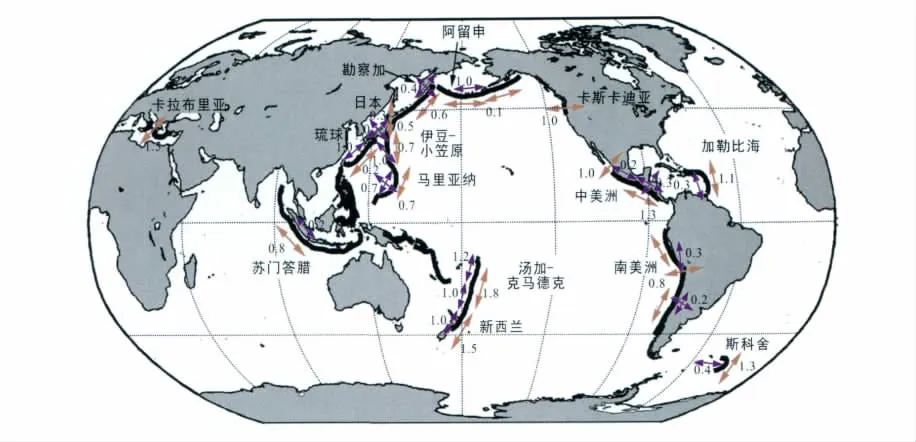
圖2 地幔楔和板下地幔的剪切波分裂的特征(分別以藍色與紅色表示)。雙箭頭表示剪切快波的平均偏振方向(φ),箭頭邊上的數字表示剪切快慢波之間平均的延遲時間(δt,以秒為單位)。所用資料來自Long and Becker(2010)。Fig.2 Shear wave splitting patterns of mantle wedge(blue)and subwedge mantle(red).Arrows indicate average fast polarization directions(φ),and numbers show the associated average delay times(δt,in sec).Data from Long and Becker(2010).
地幔楔的剪切波分裂情況比較復雜。一部分俯沖帶的φMW平行海溝,如阿留申列島、日本海和本州島西部(Fouch and Fischer,1996)、新西蘭的希庫朗伊(Hikurangi)俯沖帶 (Marson-Pidgen et al.,1999)、蘇門答臘地區(Hammond et al.,2010);另一部分俯沖帶的φMW基本垂直或高角度斜交于海溝,如伊豆-小笠原-馬里亞納群島(Fouch and Fischer,1996)和智利的西北部(Polet et al.,2000)。有趣的是,在一些俯沖帶(例如日本的東北部)出現從海溝向弧后盆地方向φMW轉變的情況:在弧前或海溝附近,φMW平行海溝,但在弧后盆地φMW垂直于海溝(Nakajima and Hasegawa,2004;Huang et al.,2011)。但是與上述情況相反的轉變也有報導,例如在勘察加半島,在海溝附近,φMW垂直于海溝,但在弧后盆地 φMW卻平行于海溝(Levin et al.,2004)。還有的地幔楔,其φMW方向的變化更為復雜,尚難以歸納其特征,如日本從南部的九州到北邊的北海道,φMW時而平行、垂直或斜交于海溝走向(Salah et al.,2008;Wirth and Long,2010)。在全球范圍內,δtMW(地幔楔的快慢波之間的延遲時間)變化范圍也很大,如在南美的西海岸(Russo and Silver,1994)、中美洲的哥倫比亞(Shih et al.,1991),地幔楔近乎各向同性(δtMW=0.1~0.4 s);而在新西蘭的希庫朗伊俯沖帶,δtMW卻高達1.5 s(Marson-Pidgen et al.,1999)。
為了解釋俯沖帶的剪切波分裂性質的復雜性和多樣性,學界已經提出了數種成因模式,我們將對其中主要的模式做些評介。需要強調的是,目前尚沒有一個統一的成因模式能夠解釋世界上所有俯沖帶的地震波各向異性的特點,研究還有待深入。
2 地幔楔拐角流
形成地震波各向異性的因素有很多,主要包括:(1)互層巖石的復合構造,各成分層具不同的彈性力學性質,可以是各向同性也可以是各向異性的(Backus,1965;Ji et al.,2004;Ji,2008),垂直層理的波速總是較低,而平行層理的波速較高。(2)巖石中裂隙或微裂隙的定向排列,裂隙既可以被氣體、液體或熔體填充(Crampin and Booth,1985;Kendall,1994;Wang and Ji,2009),在垂直定向裂隙面的方向上波速較低,而在平行定向裂隙面的方向上波速較高;(3)各向異性礦物的晶格優選定向(LPO),上地幔的各向異性一般認為是由其主要造巖礦物橄欖石和輝石的 LPO所致(Hess,1964;Nicolas and Christensen,1987;Ji et al.,1994;Mainprice,2007)。橄欖石在上地幔中含量最多,其單晶體的地震波速各向異性較大(圖3),P波的各向異性系數高達22.9%,最大Vp(10.0 km/s)平行于[100]方向,最小Vp(7.7 km/s)平行于[010]方向,在[001]方向上Vp=8.4 km/s(Ji et al.,2002)。橄欖石的最大剪切波分裂達1.0 km/s,出現在[101]方向上,而在[100]方向上卻不發生剪切波分裂。目前,一般都是利用橄欖石的LPO解釋上地幔的各向異性和剪切波分裂的數據,并且認為LPO是橄欖石在上地幔條件下發生位錯蠕變的產物,因為擴散蠕變和晶界滑移主導的超塑性變形基本上不能形成LPO(Karato and Wu,1993)。但只要條件適當,位錯蠕變既可發生在巖石圈地幔(Ji et al.,1994;Silver,1996;Savage,1999),亦可在軟流圈地幔(Vinnik et al.,1992)。后者主要反映現代板塊運動,而前者主要反映地史上最后一次最強烈的構造變形,所形成的LPO“凍存”于較剛性的巖石圈地幔。在位錯蠕變場內,有限應變愈大,形成的橄欖石的LPO愈強,地震波速各向異性和剪切波分裂亦就愈大。LPO強度隨應變的增加不可能是無限制的,當有限應變達到或超過某一臨界值(例如,γ=4~5),LPO的強度就可能達到飽和狀態,不再隨著應變增加而增加。

圖3 橄欖石單晶體的地震波速分布特征。(a)橄欖石單晶體主要晶格方向上的Vp、Vs1和Vs2的值(單位為km/s,Vp>Vs1>Vs2)。(b-e)分別為橄欖石單晶體中Vp、Vs1、Vs2和δVs(=Vs1-Vs2)的等值線分布圖(單位為km/s),下半球赤平投影;a,b和c分別表示橄欖石單晶體的三個晶軸。Fig.3 Seismic velocities of olivine single crystal.(a)Vp,Vs1and Vs2values in main crystallographic directions(in km/s,Vp>Vs1>Vs2).(b-e)Vp,Vs1,Vs2and δVs(=Vs1-Vs2)are shown in equal area stereographic projection with respect to the olivine crystallographic axes of a,b,and c.

圖4 由地幔楔中二維拐角流和板下平行海溝的三維地幔流所形成的剪切波分裂特征。無論在地幔楔還是板下地幔中,橄欖石皆發育A型組構。Fig.4 Shear wave splitting patterns produced by 2D corner flow in the mantle wedge and 3D trenchparallel flow in the subslab mantle when olivine develops A-type fabrics.
自然變形和實驗變形形成的最常見的橄欖石組構就是其(010)面和[100]方向分別優勢集中到剪切面(C面)和剪切方向。隨著有限剪切應變的增加,剪切面和剪切方向與最大擠壓面(即面理或有限應變橢球的XY面)和最大拉伸方向(即有限應變橢球的X軸)之間的夾角逐漸減小。俯沖板塊與地幔楔之間的流變學耦合(Rheological coupling)常在地幔楔中形成二維拐角流(圖4),橄欖石發生位錯蠕變,使其(010)面和[100]方向分別平行于地幔流的流面和流線。該模式預測,地幔楔的φMW方向平行俯沖板塊的絕對運動方向,即垂直或高角度斜交于海溝的走向;δtMW的變化應主要取決于板塊的運動速度和俯沖角度的大小。板塊的運動速度越大,拐角流的規模就越大,應變也就越大,LPO的強度也應更大。對于俯沖角度幾乎保持恒定的同一地區來說,δtMW應該比較均一,變化范圍不應太大(McKenzie, 1979;Ribe,1989;Fischer et al.,2000),這與一些弧后地區的剪切波分裂的資料吻合,如湯加-克馬德克俯沖帶的西部(Fischer and Wiens,1996)和伊豆-小笠原的弧后地區(Fouch and Fischer,1996)。從理論上說,靠近海溝即接近地幔楔的楔角頂部(圖4),地幔可能會出現滯流,形成的LPO強度也就弱,因為那里的應變量并不大,甚至會出現平行海溝的側向流動,使得φMW平行于海溝,形成較為復雜的LPO樣式及其隨空間位置的變化,導致φMW和δtMW數據的離散。
Buttles and Olson(1998)對拐角流進行了簡易的物理模擬實驗,說明板塊俯沖角度對地幔楔內礦物的LPO強度有著較為重要的影響。Fischer et al.(2000)做過一些數值模擬實驗,其結果表明由拐角流所形成的橄欖石和斜方輝石的LPO樣式可以解釋湯加俯沖帶之上地幔楔的剪切波分裂的特征。然而,二維拐角流模型目前尚無法解釋某些地區地幔楔φMW平行于海溝的特征,甚至對φMW垂直于海溝的地幔楔的解釋也仍需進一步完善。此外,二維拐角流模式預言的δtMW與板塊運動速度呈正相關,這與實際觀測數據的統計結果尚不吻合(Long and Silver,2008)。
3 海溝遷移
Russo and Silver(1994)首次在剪切波分裂的解釋中注意到板塊后退(Slab rollback)和海溝遷移(Trench migration)的影響(圖5),認為它們是引發平行海溝的地幔流(圖4)、形成南美洲平行于海溝走向的φSW的主要因素。對此,Buttles and Olson(1998)還進行了物理模擬實驗,實驗結果證明俯沖板塊后退導致的平行海溝的地幔流足以形成所觀察到的平行海溝的φSW,他們預言地震波速各向異性的強度與海溝的總遷移量有關。其他學者也對平行海溝的三維地幔流開展了一系列物理模擬(Kincaid and Griffiths,2003;Funiciello et al.,2006)和數值模擬(Piromallo et al.,2006;Stegman et al.,2006;Schellart et al.,2007;Becker and Faccenna,2009)。最近,Long and Silver(2008,2009)又對海溝或俯沖板塊遷移引發的平行于海溝的地幔流的概念做了進一步的發展和完善。當大洋板塊的俯沖角度由緩變陡(圖5a),位于大洋一側的板下地幔必然受到俯沖板塊的擠壓,導致平行海溝的塑性流動,形成橄欖石[100]方向平行于海溝的強烈的LPO,其結果導致φSW平行于海溝走向。大洋板塊俯沖角度的由緩變陡可能是一種較為普遍的地質現象(Hsui et al.,1990;Houseman and Gubbins,1997),俯沖洋殼(玄武巖和輝長巖)先轉變成密度大的榴輝巖然后再轉變成密度更大的石榴子石巖(Ringwood,1991;Ji and Zhao,1994);在地幔轉換帶(Transition zone)內,橄欖石也會轉變成密度更大的尖晶石(γ相),俯沖的大洋板塊在重力作用下必然要發生由緩變陡的旋轉;另一種地質作用也可以導致平行海溝的地幔流,即海溝遷移。若俯沖板塊后退,則遷移的板塊擠壓著板下地幔(圖5b),導致φSW平行于海溝走向(圖4)。若俯沖板塊前進,則遷移的俯沖板塊擠壓著地幔楔(圖5c),導致φMW平行于海溝走向。Long and Silver(2008,2009)分析了世界上15個俯沖帶的δtSW與板塊運動速率、海溝遷移速率、俯沖板塊年齡及其傾角、地震最大深度等構造參數的相關性,他們發現只有海溝遷移速率(Heurt and Lallemand,2005)與δtSW之間具有較好的線性關系(R=0.72)。在海溝遷移速率很小或幾乎為零的阿留申群島,δtSW也很小或近乎為零,即各向同性。但在湯加-克馬德克地區,海溝遷移速率高達5 cm/a,δtSW的平均值為 1.8 s,最大值高達 2.4 s(圖6a)。眾所周知,剪切快慢波之間的延遲時間與其穿越的各向異性介質的厚度及該介質各向異性的強度成正比。遷移速率快的板塊俯沖系統可以引發更大規模的平行海溝的地幔流,從而在較大范圍內產生高強度的上地幔礦物的晶格優勢定向,這就解釋了δtSW與俯沖板塊遷移速率呈正相關的原因。但是,Long and Silver(2008,2009)并沒有考慮到海溝遷移方向對地幔流的可能影響。統計結果(Gripp and Gordon,2002;Funiciello et al.,2008)顯示,占全球俯沖帶總長度53%的海溝作前進運動,其余47%的海溝作后退運動。在海溝后退過程中(如南美洲西海岸的俯沖帶,中美洲西海岸的俯沖帶以及西太平洋的琉球俯沖帶等),俯沖板塊擠壓著板下地幔,主要影響著俯沖帶外側的φSW和δtSW。但是,在海溝前進過程中(如伊豆-小笠原-馬里亞納俯沖帶、克馬德克俯沖帶、蘇門答臘俯沖帶等),俯沖板塊擠壓著地幔楔,主要影響著俯沖帶內側的φMW和δtMW,而對φSW和δtSW理應沒有什么直接影響。在Long and Silver(2008,2009)的統計圖(圖6a)上,并沒有考慮到海溝遷移方向的影響,故其統計結果及其地質意義尚有待于進一步明確。
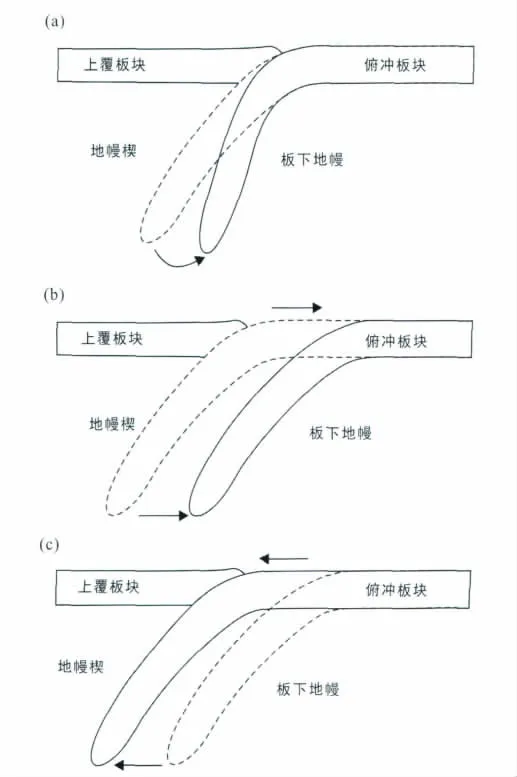
圖5 俯沖板塊旋轉(a)、后退(b)和前進(c)的模式示意圖。虛線和實線分別表示變化前后俯沖板塊的位置,箭頭表示板塊的運動方向Fig.5 Schematic diagrams of rotating(a),retreating(b)and advancing(c)slabs.Dashed and solid lines indicate slab locations before and after the change,respectively.Arrows indicate the motions of the trench and the subducting slab
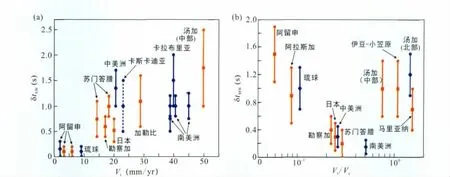
圖6 (a)俯沖板塊和板下地幔的剪切波延遲時間(δtSW)隨海溝遷移速率(Vt)的變化。(b)地幔楔的剪切波延遲時間(δtMW)與Vt/Vc的關系,Vt/Vc表示海溝遷移速率與板塊運動速率的比值。紅色和藍色分別表示前進的和后退的海溝,不同的符號代表不同的俯沖帶。建圖數據來自Long and Silver(2008)Fig.6 (a)Average subwedge delay time(δtSW)versus trench migration velocity(Vt).(b)Average mantle wedge delay time(δtMW)versus Vt/Vc.Vt/Vcrepresents trench migration velocity normalized by total convergence velocity.Retreating and advancing trenches are represented by blue diamonds and red squares,respectively(Data from Long and Silver,2008)
需要強調的是,當俯沖板塊向前遷移時,在地幔楔內會同時存在垂直于海溝的二維拐角流和平行于海溝的三維地幔流(圖4),所以,地幔楔的剪切波分裂樣式應是上述兩種作用彼此競爭的結果(Long and Silver,2008,2009)。如果板塊運動速率Vc和海溝遷移速率Vt分別影響著垂直于海溝的拐角流和平行于海溝的地幔流的強度和規模,那么當Vt/Vc比值較小時(<~0.2),地幔楔內則以拐角流為主,φMW會垂直于海溝,δtMW會隨Vt/Vc比值減小而增大(圖6b)。相反,如果海溝遷移占主導(即Vt/Vc比值大于~0.6),則δtMW與海溝遷移速率呈正相關,即δtMW隨Vt/Vc比值增大而增大(圖6b)。介于上述兩種極端情況之間的其他俯沖系統,垂直于海溝的拐角流和平行于海溝的地幔流兩種作用勢均力敵,所形成的各向異性彼此消減,故觀察到的δtMW值就小(圖 6b)。雖然 Long and Silver(2008,2009)的理論模式能較為合理地解釋地幔楔的δtMW資料,卻不能圓滿地解釋每一條俯沖帶的φMW數據。例如,在伊豆-小笠原俯沖帶,海溝遷移速率約為 5 cm/a,Vt/Vc比值約為1,Long and Silver(2008,2009)把該俯沖帶歸入海溝遷移主導的類型,即俯沖板塊之上的地幔楔的φMW平行于海溝,然而實際觀察到的卻是垂直海溝。阿留申俯沖帶的海溝幾乎靜止不動,既不前進也不后退,Long and Silver(2008,2009)將之劃歸二維拐角流主導的類型,然而,實際觀察的φMW卻是平行海溝的(圖2)。此外,世界上大多數俯沖帶的海溝遷移速度Vt總比板塊俯沖速度Vc要小得多,即Vt/Vc<<1,理應在大多數情況下二維拐角流強于三維地幔流,即垂直于海溝的φMW要比平行于海溝的φMW更為常見,這個問題尚有待進一步探討。
另外,Long and Silver(2008,2009)提出的三維地幔流的可行性的三個必要條件皆有疑問。第一個條件是,俯沖板塊與其板下地幔之間不發生流變學耦合,這樣大洋板塊在俯沖過程中才不會拖曳著板下地幔向著俯沖方向一起流動,板下地幔才能作平行于海溝的側向流動。為了滿足上述條件,Morgan et al.(2007)假設在俯沖板塊與板下地幔之間存在著一個流變強度極低的薄層(10~30 km),它可能是高溫的、含水量高的軟流圈的物質,被強拖到俯沖板塊與板下地幔之間,該假說還有待證實。三維地幔流可行性的第二個條件要求在地幔轉變帶深度(410 km)或上下地幔邊界(660 km)位置存在高強度的力學阻隔層(例如石榴子石巖層,Ringwood,1991),低溫高強度的俯沖板塊能夠通過而高溫低強度的板下地幔流卻不能通過,這樣,地幔流就可以在俯沖板塊遷移的驅趕下作平行于海溝的側向水平流動。目前,震源和地震波層析數據已證實俯沖板塊可以穿越轉變帶和660 km不連續面并插入下地幔(van de Hilst et al.,1997;Li et al.,2008)。但是,上地幔的板下地幔流能否進入下地幔以及轉變帶內地幔流的強度與規模,目前尚無定論,爭議依然很大(Tackley,2008)。三維地幔流可行性的第三個條件要求,在垂直俯沖帶方向的遠處存在某種強大的力量,驅趕著熱的、流變強度低的板下地幔物質向著俯沖帶方向運動,靠近俯沖板塊時,由于冷的高強度的俯沖板塊的阻擋,地幔流被迫作平行于海溝的側向水平流動(Buttles and Olsen,1998;Kincaid and Griffiths,2003)。上述神秘的力量或許就是熱-浮力驅動的上升地幔流或地幔柱。據此推理,靠近洋中脊的南美洲西海岸的板下地幔的δtSW應該大于遠離洋中脊的湯加-克馬德克-新西蘭俯沖帶的板下地幔的δtSW,然而,事實并非如此,可見上述的第三個條件并非必要條件。
4 橄欖石B型組構的特殊性
傳統的實驗資料(Carter and Ave Lallemant,1970)表明,在實驗室應變速率條件下,橄欖石的位錯滑移系隨溫度升高逐漸由(100)[001]過渡到{110}[001],然后再變為{0kl}[100],最后到(010)[100](圖7a),這4個滑移系之間相互轉變的臨界溫度隨圍壓增加而逐漸減小。在正常的上地幔溫壓條件下,最流行的橄欖石滑移系應該是(010)[100],這與世界上許多地方玄武巖或金伯利巖中地幔包體的橄欖石組構是一致的(Nicolas and Christensen,1987;Mainprice and Silver,1993;Ji et al.,1994,1996;Saruwatari et al.,2001)。但是,Carter and Ave Lallemant(1970)的實驗是在固體圍壓介質的Griggs裝置上完成的,由于當時技術條件的局限性,差應力的測量精度不夠,巖石試樣中甚至還可能存在較大的溫度不均勻性,同時水的影響亦沒有得到有效地控制。
近年來,美國耶魯大學唐戶俊一郎(Shun-ichiro Karato)教授領導的研究組(Jung and Karato,2001;Karato,2002;Katayama et al.,2004;Skemer et al.,2006;Jung et al.,2006)針對水對橄欖石LPO類型的影響做了一系列的實驗探討(圖7b),他們認為,在正常差應力(<350~400 MPa)作用下,隨著水含量的增加,橄欖石的位錯滑移系從(010)[100]先轉變成(001)[100],然后再轉變到(100)[001]。但在高差應力(>350~400 MPa)作用下,橄欖石在低水含量和中-高水含量的情況下分別出現{0kl}[100]和(010)[001]滑移系。由滑移系(010)[100]、(010)[001]、(100)[001]、{0kl}[100]、(001)[100]和{110}[001]位錯蠕變形成的 LPO 分別稱之為A型、B型、C型、D型、E型和F型組構(圖7c)。
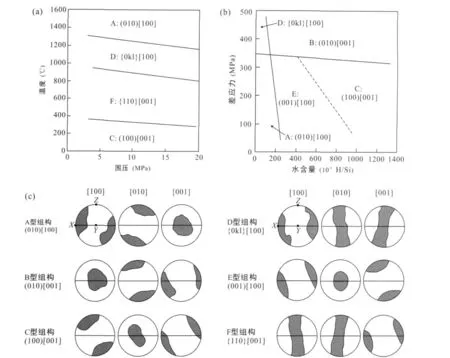
圖7 在不同溫度、壓力、差應力和水含量條件下,橄欖石的6個主要滑移系(a和b)所形成的6種主要類型的組構(c)。(a)建圖數據取自Carter and Ave Lallemant(1970),應變速率為7.8×10-5s-1;(b)建圖數據取自Jung and Karato(2001)和 Jung et al.(2006),變形溫度1200~1300 ℃,應變速率為 5.6×10-6~9.5×10-4s-1Fig.7 (a).Deformation fabrics of olivine at stain rate~7.8 ×10-5s-1as a function of temperature and pressure(Data from Carter and Ave Lallemant,1970).(b).Deformation fabrics of olivine at 1200~1300 ℃ and a stain rate of 5.6×10-6~9.5 ×10-4s-1as a function of differential stress and water content(Data from Jung and Karato,2001 and Jung et al.,2006).(c).Typical pole figures of A,B,C,D,E and F-type LPOs in(a)and(b).Pole figures are presented in equal area stereographic projection with respect to three principal axes(X,Y,and Z)of the finite strain ellipsoid
然而,學界對唐戶俊一郎等的結論目前尚存很大的爭議,主要因為他們的實驗結果尚未被其他實驗室重復驗證(Li et al.,2003a,b;Couvy et al.,2004;Li et al.,2004;Raterron et al.,2004,2007;Ji et al.,2007)。例如,美國紐約大學石溪分校的礦物物理研究所和法國里爾大學固體結構與性質實驗室的研究人員更強調圍壓對橄欖石位錯滑移系轉變的重要性。Couvy et al.(2004)報道,在圍壓11 GPa(對應于約330 km的深度)、溫度1400℃和簡單剪切條件下,橄欖石的主要滑移系為{110}[001],形成F型組構。在溫度1100~1400℃和無水條件下,Raterron et al.(2007)發現隨著圍壓的增加(2.1~7.5 GPa)橄欖石最容易滑移的晶系由(010)[100](A型組構)轉變為(010)[001](B型組構)。如果Raterron et al.(2007)的實驗結果可以外延到更深的上地幔,那么在200~400 km深度范圍內所流行的就可能是B型組構而不是A型組構。后來,Jung et al.(2009)在溫度1270~1300℃、圍壓3.1~3.6 GPa、差應力 150~390 MPa,應變率2×10-5~6×10-5的條件下簡單剪切(γ=3~6)了干的橄欖石多晶結合體,同樣也獲得了B型組構,這就說明高水含量并不是形成橄欖石B型組構的唯一條件。如果上述實驗結果可外延到自然界,那么B型組構在80~100 km深度以下的地幔就可能存在了。所以,影響橄欖石組構轉變的因素至少應該有4個:溫度、差應力、水含量和圍壓。但是,圖7c所示的6種類型組構之間相互轉變的準確的邊界條件,迄今尚不甚明確,仍需進一步研究。
由于橄欖石的A型、D型和E型組構都是由平行于[100]方向的位錯滑移造成的,該方向是橄欖石晶體中波速最大的方向(圖3)。所以,這三種類型中任一種LPO總會使得剪切快波的偏振方向平行于地幔的流動方向。但是,若在地幔流動過程中,橄欖石作{110}[001]滑移,[001](中間波速)的最大集密平行于拉張線理(X),而[100](最大波速)和[010](最小波速)方向皆形成垂直于拉張線理的環帶,構成F型組構,當剪切波在垂直于地幔流動面(XY面)方向上傳播時幾乎不發生分裂。若在地幔的塑性流動過程中,橄欖石作(100)[001]滑移,[001](中間波速)的最大集密平行于拉張線理,[100](最大波速)方向垂直于面理,[010](最小波速)方向平行于面理且垂直于拉張線理,構成C型組構,當剪切波在地幔流動面的垂直方向上傳播時,快波的偏振方向依然平行于地幔流方向,但是此時快慢波之間的延遲時間就不如同等條件下A型組構形成的那么大。
橄欖石的B型組構(圖7)造成的地震波各向異性的樣式和其他類型組構的明顯不同,有必要在此作重點討論。B型組構是由(010)[001]位錯滑移造成的,[001](中間波速)方向的最大密集平行于拉張線理,[010](最小波速)方向垂直于面理,[100](最大波速)方向平行于面理且垂直于拉張線理。如果地幔作近乎水平的流動,則最小波速近乎垂直,而在水平面上最大波速則垂直于地幔流動方向。當剪切波在地幔流動面的垂直方向上傳播時,快波的偏振方向就會垂直于而不是平行于地幔流的方向,這和所有其他類型橄欖石組構造成的地震波各向異性是截然不同的。
目前最關鍵的問題是A型與B型組構之間準確的轉變條件,迄今尚不清楚。如果B型組構形成的必要條件是高水含量(>200×10-6H/Si)和高差應力(>320 MPa,Jung and Karato,2001;Jung et al.,2006;Karato et al.,2008),那么我們可進行如下探討。在地幔巖的部分熔融過程中,水會優先進入熔體(Karato,1986;Hirth and Kohlstdt,1996;嵇少丞等,2008),水在熔體和橄欖石之間的分配系數是 104∶1(Grant et al.,2007)。所以,部分熔融程度越高,其難熔的殘余組分如橄欖石就愈“干燥”,也就愈不容易形成B型組構。大洋巖石圈地幔相對于其下的軟流圈地幔經過了更高程度的部分熔融,洋中脊就是地幔發生部分熔融的場所,大洋巖石圈地幔可以看成是由經過較高程度部分熔融之后的殘余組分(方輝橄欖巖和純橄巖)構成的,其中橄欖石的含水量甚少,所以,B型組構在大洋巖石圈地幔中是不可能大規模存在的。在島弧之下,地幔楔也發生了較為強烈的部分熔融,水優先進入玄武巖熔體并侵入地殼或噴發到地表,巖漿源區的方輝橄欖巖中的橄欖石就相對變干,所以也不會形成B型組構。有的學者認為最有可能形成B型組構的地區是弧前地幔楔(Katayama and Karato,2006;Kneller et al.,2005,2007,2008),因為由俯沖板塊脫水作用釋放出來的水擴散進入地幔楔內的橄欖石晶體。然而,這些水也能與弧前地幔楔中的橄欖巖發生水化反應生成蛇紋石,蛇紋石的流變強度比橄欖石的低得多(圖8,Brodie and Rutter,1987;Escartin et al.,2001;Hilairet et al.,2007;Chenak and Hirth,2010),應變將發生局部化并優先集中到蛇紋石之中。所以,在蛇紋石化橄欖巖中差應力是不可能很高的,那么需要在很高差應力條件下才能形成的橄欖石的B型組構也不可能出現在蛇紋石化的弧前地幔楔中。
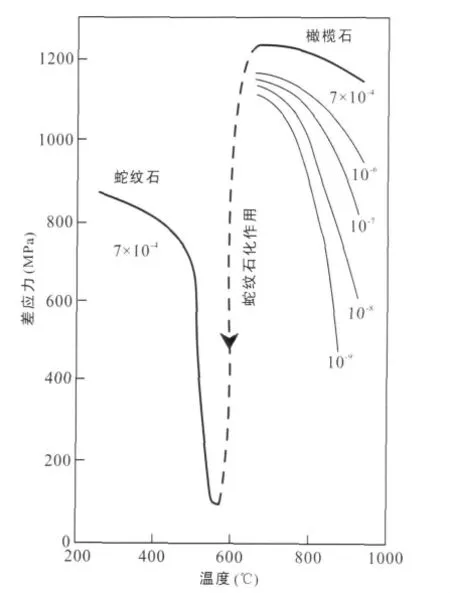
圖8 橄欖石和蛇紋石流變強度的比較及其蛇紋石化的作用。曲線邊上的數字表示應變速率。建圖數據取自Brodie and Rutter(1987)Fig.8 Comparison of flow strengths between olivine and serpentine.Strain rate(in s-1)is indicated for each curve.Dashed curve shows the effect of serpentinization.(Data from Brodie and Rutter,1987)
如果由于某些尚不為人知的原因,橄欖石的B型組構確實流行于弧前地幔楔中(Kneller et al.,2005,2007,2008;Mizukami et al.,2004;Skemer et al.,2006;Michibayashi et al.,2007;Tasaka et al.,2008),在二維拐角流的作用下,B型組構導致橄欖石的[100]方向平行于海溝,(010)面平行于地幔流動面,φMW也就平行于海溝,那么也就無需利用平行海溝的地幔流的假說來解釋弧前地幔楔的剪切波分裂的資料。如果上述觀點是正確的,以島弧為界的地幔楔就可分為弧前地幔楔和弧后地幔楔,弧前地幔楔和弧后地幔楔分別以B型和A型組構為特征,造成弧前和弧后的φMW分別平行和垂直于海溝(圖9),這樣的分布在日本北海道和本州可以見到(Nakajima and Hasegawa,2004;Huang et al.,2011)。然而,在琉球俯沖帶和湯加俯沖帶的弧前地區,φMW皆是平行海溝的,但是,在琉球弧后大部分地區,φMW也是平行于海溝的(Long and van der Hilst,2006),而湯加弧后地區(Lau盆地)的φMW既不垂直海溝也不平行海溝,而是斜交于海溝(Smith et al.,2001)。在馬里亞納俯沖帶(Pozgay et al.,2007)和中美洲西海岸的哥斯達黎加(Costa Rica)和尼加拉瓜(Nicaragua)俯沖帶(Abt et al.,2009;Hoernle et al.,2008)的弧后地區也發現有平行于海溝的φMW,甚至在勘察加南部(Levin et al.,2004)和北美洲阿拉斯加地區(Christensen et al.,2010),φMW在弧前垂直于海溝,在弧后卻是平行海溝的,這些復雜的現象尚難以用橄欖石的B型和A型組構的轉變來解釋。

圖9 地幔楔中橄欖石的弧前B型組構和弧后A型組構對剪切波分裂的影響Fig.9 Shear wave splitting patterns resulted from olivine B-type fabrics beneath the forearc and A-type fabrics beneath the backarc
5 蛇紋石化作用
作為層狀硅酸鹽礦物的蛇紋石是超基性地幔巖的水化產物,它包括三個主要的同質多象變體,分別為利蛇紋石[Lizardite,Mg3Si2O5(OH)4]、纖蛇紋石[Chrysotile,Mg3Si2O5(OH)4)]和葉蛇紋石[Antigorite,Mg48Si34O85(OH)62]。蛇紋石作為含水礦物,影響其穩定性的主要因素是溫度,其次才是壓力(圖10)。利蛇紋石和纖蛇紋石通常在<350℃的溫度下穩定存在,稱之為低溫蛇紋石。只有葉蛇紋石能在 >350℃的溫度下穩定存在(Evans,1977),葉蛇紋石轉變成橄欖石+斜方輝石+水的邊界隨圍壓增加而減小:在2.0 GPa時是~720℃;在3.0 GPa時是~690 ℃;5.0 GPa時是~620 ℃(Ulmer and Trommsdorff,1995)。需要強調的是,在富鋁、富鉻和富水環境中上述反應邊界會向高溫方向遷移(Padron-Navarta et al.,2010)。在富水的地幔楔中,葉蛇紋石在溫度高達800~850℃時可能依然穩定。所以,葉蛇紋石應是俯沖板塊地幔內主要的蛇紋石礦物。
鎂橄欖石 (Mg2SiO4)、鐵鎂橄欖石[(Fe,Mg)2SiO4]、頑 輝 石 (MgSiO3)和 滑 石[Mg3Si4O10(OH)2]的水化反應可以有下列形式:
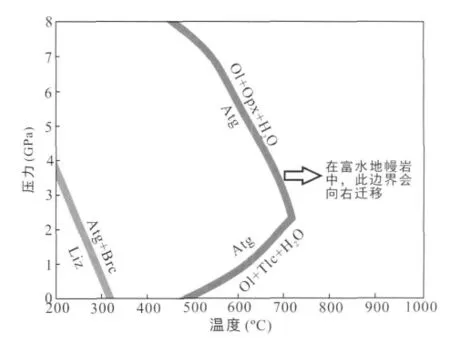
圖10 利蛇紋石和葉蛇紋石的穩定場圖。礦物簡寫:Atg葉蛇紋石,Liz利蛇紋石,Ol橄欖石,Brc水鎂石,Tlc滑石,Opx斜方輝石。相邊界條件取自Ulmer and Trommsdorff(1995)和Evans(2004)Fig.10 Diagram showing the stability fields of lizardite and antigorite.Mineral abbreviations:Atg antigorite,Liz lizardite,Ol olivine,Brc brucite,Tlc talc,Opx orthopyroxene.Reaction boundaries are given by Ulmer and Trommsdorff(1995)and Evans(2004)
(1)鎂橄欖石+頑輝石+水→葉蛇紋石
14Mg2SiO4+20MgSiO3+31H2O→Mg48Si34O85(OH)62
(2)鎂橄欖石+滑石+水→蛇紋石
6Mg2SiO4+Mg3Si4O10(OH)2+9H2O→5Mg3Si2O5(OH)4
或18Mg2SiO4+4Mg3Si4O10(OH)2+27H2O→Mg48Si34O85(OH)62
(3)鎂橄欖石+二氧化硅+水→低溫蛇紋石
3Mg2SiO4+SiO2+4H2O→2Mg3Si2O5(OH)4
(4)鎂橄欖石+水→蛇紋石+水鎂石
2Mg2SiO4+3H2O→Mg3Si2O5(OH)4+Mg(OH)2
或34Mg2SiO4+51H2O→Mg48Si34O85(OH)62+20Mg(OH)2
(5)頑輝石+水→葉蛇紋石+滑石
90MgSiO3+45H2O→Mg48Si34O85(OH)62+14Mg3Si4O10(OH)2
(6)鐵鎂橄欖石+水+二氧化碳→低溫蛇紋石+磁鐵礦+甲烷
(Fe,Mg)2SiO4+H2O+CO2→Mg3Si2O5(OH)4+Fe3O4+CH4
(7)鐵鎂橄欖石+水+二氧化碳→低溫蛇紋石+磁鐵礦+菱鎂礦+二氧化硅
(Fe,Mg)2SiO4+H2O+CO2→Mg3Si2O5(OH)4+Fe3O4+MgCO3+SiO2
(8)鎂橄欖石+水+二氧化碳→滑石+菱鎂礦
4Mg2SiO4+H2O+5CO2→Mg3Si4O10(OH)2+5MgCO3
(9)滑石+水→低溫蛇紋石+二氧化硅
Mg3Si4O10(OH)2+H2O→Mg3Si2O5(OH)4+2SiO2
(10)滑石+菱鎂礦+水→低溫蛇紋石+二氧化碳
Mg3Si4O10(OH)2+3MgCO3+3H2O→2Mg3Si2O5(OH)4+3CO2
低溫的利蛇紋石和纖蛇紋石向高溫葉蛇紋石轉變的反應式如下:
(11)低溫蛇紋石→葉蛇紋石+水鎂石
17Mg3Si2O5(OH)4→Mg48Si34O85(OH)62+3Mg(OH)2
(12)低溫蛇紋石+二氧化硅→葉蛇紋石+水
16Mg3Si2O5(OH)4+2SiO2→Mg48Si34O85(OH)62+H2O
(13)低溫蛇紋石→葉蛇紋石+鎂橄欖石+水
20Mg3Si2O5(OH)4→Mg48Si34O85(OH)62+6Mg2SiO4+9H2O
反應式(1~2)和(11)的溫壓條件見圖10,其他反應式的溫壓條件尚有待進一步的實驗確定。蛇紋石的脫水反應是式(1~10)水化反應的逆反應。
近年來蛇紋巖對于俯沖帶動力學的意義受到了越來越多的關注,主要原因如下:(1)蛇紋巖具有很特別的物理性質,例如低的P和S波速(圖11),高的地震波各向異性和剪切波分裂(圖12,表1),以及高的Vp/Vs比值或泊松比(Ji et al.,2002;Dewandel et al.,2003;Watanabe et al.,2007;Ji et al.,2009),利用這些特性就可研發出研究俯沖帶特性的地球物理方法(Bostock et al.,2002;Faccenda et al.,2008;Boudier et al.,2009;Katayama et al.,2009);(2)蛇紋石作為俯沖帶中最重要的水的載體(~13%,Schmidt and Poli,1998;Ulmer and Trommsdorff,1995),在深部高溫條件下通過脫水作用釋放出水,造成地幔楔的部分熔融,形成島弧的巖漿作用(Hyndman and Peacock,2003;Wada et al.,2008);(3)蛇紋巖具有極低的流變強度(圖8,Brodie and Rutter,1987;Escartin et al.,2001;Hilairet et al.,2007;Chenak and Hirth,2010)和較小的摩擦系數(Moore et al.,1996;Moore and Lockner,2007),所以俯沖板塊蛇紋石化的程度直接影響俯沖帶的熱產出、地震活動性以及俯沖板塊與地幔楔之間的力學耦合,蛇紋石化程度高的區段以蠕滑為主,難以產生強震,熱產出也少,甚至影響俯沖板塊內部的熱結(Hirauchi and Yamaguchi,2007)。
大洋板塊俯沖到一定的深度,含水礦物(如蛇紋石、滑石、水鎂石)開始脫水,釋放出大量的含水流體,進入地幔楔,一方面會造成地幔楔的部分熔融,形成島弧的巖漿作用,另一方面在地幔楔內形成蛇紋石礦物,在深部主要是葉蛇紋石,但在弧前地幔楔的淺部,由于那里的溫度相對較低,利蛇紋石和纖蛇紋石也可能穩定存在(Evans,1977,2004)。已有的地質(如在伊豆-小笠原-馬里亞納群島出現大量的蛇紋石泥火山)和地球物理(如低的地震波速和高的Vp/Vs比值)數據表明,弧前地幔楔的蛇紋石化是一個全球性的普遍現象。例如,北美洲西海岸的卡斯卡迪亞(Bostock et al.,2002;Brocher et al.,2003)、日本西南部(Kamiya and Kobayashi,2000;Seno et al.,2001)、南美洲的安第斯山脈中部(Graeber and Asch,1999)和中美洲的哥斯達黎加(DeShon and Schwartz,2004)的弧前地幔楔均已發生了蛇紋巖化。
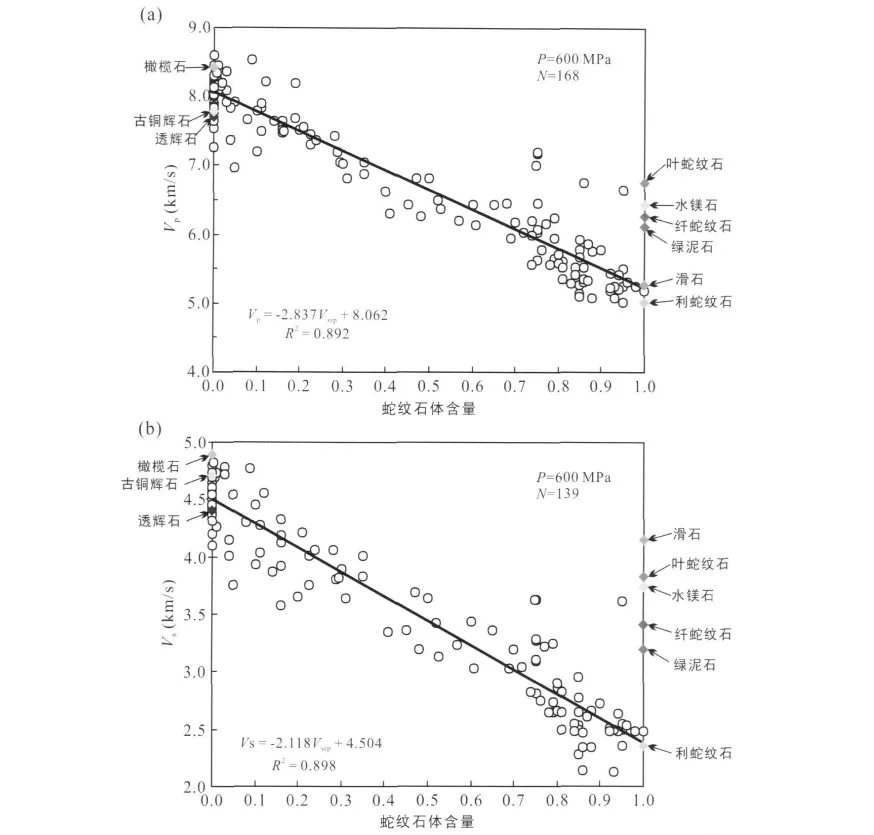
圖11 地幔巖的P波(a)和S波(b)速度隨蛇紋石化程度的增加而呈近線性地減小。波速測量的圍壓為600 MPa,N為樣品總數。地幔巖的主要礦物橄欖石、古銅輝石和透輝石及其主要水化礦物葉蛇紋石、纖蛇紋石、利蛇紋石、滑石、水鎂石和綠泥石的多晶集合體的波速也標注到圖上,以便比較Fig.11 Vp(a)and Vs(b)as a function of serpentine content for mantle rocks.Seismic velocities were measured at 600 MPa,N indicates sample numbers.Velocities of main rock-forming minerals(olivine,bronzite,and dioposide)and hydrous minerals(antigorite,lizardite,chrysotile,talc,brucite,and chlorite)are also indicated for comparison
橄欖石單晶體的P和S波的各向異性分別為~23%和~20%(圖3,Kumazawa and Anderson,1969;Ji et al.,2002),而葉蛇紋石單晶體的各向異性比這大得多(圖12),其P和S波速的各向異性分別高達46%和66%(Bezacier et al.,2010)。加之,葉蛇紋石流變強度很小(圖8),極易發生塑性變形,形成強烈的LPO:(001)面和[100]方向分別平行于蛇紋巖的剪切面和剪切方向(Katayama et al.,2009;Hirauchi et al.,2010;Kern et al.,1997),在經受強烈大變形的剪切帶(如俯沖板塊邊界層)內,上述的剪切面(即俯沖板塊邊界)和剪切方向(即板塊俯沖方向)分別近乎平行于變形巖石的面理和拉張線理。一般來說,由橄欖石的A型LPO形成的地震波各向異性僅為3%~5%,而且具有正交對稱性:最大、中間與最小P波速度分別平行于有限應變橢球的三個主軸方向,即X(礦物拉張線理)、Y(平行于面理且垂直于線理)和Z方向(垂直面理)。而由蛇紋石LPO形成的各向異性總是很強(>10%),且具有軸對稱性:最小波速垂直于面理,但在面理面上波速近乎各向同性。所以,蛇紋石含量的增加總是增強變形蛇紋石化橄欖巖在平行和垂直于面理方向上地震波速的差別,即各向異性。只要蛇紋石的含量超過~20%,則變形蛇紋石化橄欖巖的地震波各向異性特征將由蛇紋石的LPO主導,在面理上利用地震波速將無法區別X和Y方向。

圖12 葉蛇紋石單晶體中Vp、Vs1、Vs2和δVs(=Vs1-Vs2)的等值線分布圖(單位為km/s),下半球赤平投影;圖中a和b分別表示a和b晶軸,c*表示(001)的法線方向。葉蛇紋石單晶體的彈性系數由Bezacier et al.(2010)測定Fig.12 Seismic velocities of antigorite single crystal.Vp,Vs1,Vs2and δVs(=Vs1-Vs2)are shown in equal area stereographic projection with respect to the crystallographic orientations of a,b,and c*,where c*is perpendicular to(001)plane.Elasticity data of antigorite are from Bezacier et al.(2010)

表1 常溫常壓下葉蛇紋石單晶體的彈性模量(實驗數據來自 Bezacier et al.,2010)Table 1 Elastic constants(GPa)and properties of antigorite single-crystal at ambient conditions(Data from Bezacier et al.,2010)
Katayama et al.(2009)在圍壓 1.0 GPa 和溫度300~400℃的實驗條件下簡單剪切了葉蛇紋石多晶集合體,在剪切應變γ≈2.0時該蛇紋巖的剪切波各向異性(AVs)高達32%,這與自然變形的蛇紋巖的各向異性相當(Kern et al.,1997;Ji et al.,2002;Christensen,2004;Wang et al.,2005;Watanabe et al.,2007)。由此可見,蛇紋石化必然會對俯沖帶及其地幔楔的地震波速各向異性大小與樣式影響很大,可惜以前的理論模式往往忽視了蛇紋石化的貢獻。
例如,在西太平洋的琉球島弧,剪切快慢波之間的延遲時間是1~2 s,若所觀察到的剪切波分裂全部是由橄欖石的優選定向造成的(AVs=4.5%),那么各向異性層的厚度就需100~200 km,這些值在某些地方甚至要大于其下的地幔楔的厚度,這明顯是不可能的。若上述剪切波分裂是由蛇紋石的優選定向造成的(AVs=32%),那么僅需10~20 km厚度的蛇紋巖就足夠了。總之,蛇紋石化程度越高,地幔楔的各向異性也就越大,島弧地區的剪切波分裂愈強。
地幔楔的蛇紋石化程度可能與俯沖板塊的年齡有關。年輕的俯沖板塊,內部溫度梯度較高,會在弧前地區釋放出大量的鍵間水,那里地幔楔的蛇紋石化程度因此較高;相反,在古老的俯沖板塊內部,溫度梯度較低,脫水反應會發生在更深處,弧前地區地幔楔的蛇紋石化程度因此較低(Wada et al.,2008)。西太平洋的琉球俯沖帶屬于低齡高溫型,脫水反應發生在~40 km的深度,弧前的地幔楔會發生廣泛的蛇紋石化作用,故剪切波的延遲時間較大(1~2 s)。日本東北部的俯沖帶屬于高齡低溫型,脫水反應主要發生在100 km左右的深度,故弧前地幔楔的蛇紋石化程度很低,剪切波延遲時間僅 0.1~0.2 s。
蛇紋石化最強烈的部位很可能出現在俯沖板塊與地幔楔之間的接觸剪切帶內,并在那里形成蛇紋巖層(圖13a),由于其流變強度較兩側橄欖巖的低得多,逆沖剪切應變會在該蛇紋巖層中高度集中,形成強烈的葉蛇紋石LPO:(001)面平行于地幔楔與俯沖板塊的接觸面,而[100]方向平行于俯沖方向,造成最大和最小的波速分別平行于和垂直于面理方向。由于剪切波分裂技術目前僅測定介質中其傳播方向的垂直面(對應于SKS和SKKS來說該面就是水平面)上的最大波速方向,所以無論φMW或δtMW都與俯沖角度有很大關系。如果俯沖帶陡傾[例如馬里亞納俯沖帶、湯加-克馬德克俯沖帶、斯科舍(Scotia)俯沖帶],則在俯沖板塊與地幔楔的接觸剪切帶內的水平面上,最大與最小波速應分別平行于和垂直于海溝的走向。相反,如果俯沖帶呈低角度(例如南美洲西海岸),則俯沖板塊與地幔楔之間的接觸剪切帶內的蛇紋巖層也呈低角度,故對地表臺站測量到的剪切波分裂貢獻較少。

圖13 (a).由位于俯沖板塊與地幔楔之間的蛇紋巖剪切帶形成的剪切波分裂的特征。在剪切帶內,蛇紋石的(001)面平行于剪切面,而[100]方向平行于剪切方向;(b).充填于俯沖板塊張裂隙中的蛇紋石與剪切快波偏振方向的關系。蛇紋石的(001)面平行于張裂隙壁;在俯沖板塊內橄欖石發育A型組構,即(010)面平行于俯沖板塊,而[100]方向平行于板塊俯沖方向Fig.13 (a).Shear wave splitting patterns produced by a serpentinized shear zone between the subducting slab and the mantle wedge.Serpentine in the shear zone is characterized by(001)plane parallel to shear plane,and[100]axis parallel to shear direction.(b).Shear wave splitting patterns induced by serpentinized fractures in subducting oceanic plates.Serpentine has a maximum concentration of(001)plane parallel to fault plane.Olivine in the subducting plate developed A-type LPO with(010)plane parallel to subducting plates and[100] axis parallel to subducting direction
剪切快波偏振方向平行于海溝也可能是由大洋俯沖板塊上層沿斷裂面發生的蛇紋石化造成的(圖13b),條件是這些由定向蛇紋石充填的定向張破裂沒有被后來的剪切變形破壞或重新定向與構造置換。物理模擬和實驗觀察證實大洋俯沖板塊上層發育的張斷裂近乎垂直或陡傾(Feccenda et al.,2008;Jiao et al.,2000;Ranero et al.,2005)。每條斷裂的兩壁上超基性巖的主要造巖礦物橄欖石和輝石經水化形成蛇紋石、滑石和水鎂石等層狀礦物。Boudier et al.(2009)利用透射電鏡(TEM)和電子背散射衍射(EBSD)技術研究了Utah-Farallon俯沖帶內超基性巖中葉蛇紋石和橄欖石組構之間的定向關系,發現了兩種拓撲關系:(1)橄欖石的(100)面平行于葉蛇紋石的(001)面,橄欖石的[001]方向平行于葉蛇紋石的[010]方向,橄欖石的[010]方向平行于葉蛇紋石的[100]方向,這樣拓撲關系記著:(100)ol∥(001)atg,[001]ol∥[010]atg,[010]ol∥[100]atg;(2)橄欖石的(010)面平行于葉蛇紋石的(001)面,橄欖石的[001]方向平行于葉蛇紋石的[010]方向,橄欖石的[100]方向平行于葉蛇紋石的[100]方向,這樣的拓撲關系記著(010)ol∥(001)atg,[001]ol∥[010]atg,[001]ol∥[100]atg。
其中第一種拓撲關系在俯沖板塊中更為常見,橄欖巖發育A型組構(圖7),橄欖石[100]的優選方向平行于橄欖巖的拉張線理,而張裂隙則垂直于該線理,裂隙內葉蛇紋石的(001)面平行于裂隙面生長,故葉蛇紋石的(001)面垂直橄欖石[100]的優選方向。因為橄欖石的快波極化方向平行其[100]方向,而蛇紋石的快波極化方向平行于(001)面方向,所以具第一種拓撲關系的蛇紋石化橄欖巖的剪切波分裂特征取決于巖石中橄欖石的LPO強度、蛇紋石的含量及其LPO強度。一般來說,由橄欖石LPO形成的地震波各向異性僅為3%~5%,而由蛇紋石LPO形成的各向異性總是很強(甚至可以高達15%~25%)。所以,只要蛇紋石的含量超過20%,則蛇紋石化橄欖巖的剪切波分裂就由蛇紋石的LPO主導。如圖13b所示,由蛇紋石LPO主導的剪切快波偏振方向平行于張裂隙的走向,俯沖板塊上層中這些陡傾的張裂隙又垂直于板塊的總體運動方向或平行于海溝走向,這就很容易解釋為什么剪切快波偏振方向平行于海溝的走向。
地幔楔的地震波各向異性特征應是葉蛇紋石LPO和A型橄欖石LPO相互競爭的結果。在地幔楔內的拐角流作用下,橄欖石形成A型組構,理應使得φMW垂直于海溝走向。但是,蛇紋石化作用將改變地幔楔各向異性的樣式。例如,占全巖體積約10%~20%的蛇紋石化作用幾乎能全部抵消由橄欖石LPO形成的各向異性,使整體巖石近乎各向同性。如果地幔楔橄欖巖中蛇紋石的體積分數大于20%,且具有前述的第一種拓撲關系(Boudier et al.,2009),那么地幔楔整體的 φMW則受蛇紋石LPO的控制。由于蛇紋石的(001)面垂直于海溝走向,故測量到的φMW是平行于海溝的。如果上述解釋是正確的,那么φMW與海溝走向的幾何定向關系就是地幔楔中蛇紋石化程度與分布的度量。
嵇少丞,王茜,許志琴.2008.華北克拉通破壞與巖石圈減薄.地質學報,82(2):174-193.
Abt D L,Fischer K M,Abers G A,Protti M,González V and Strauch W.2010.Constraints on upper mantle anisotropy surrounding the Cocos slab from SK(K)S splitting.J Geophys Res,115,B06316,doi:10.1029/2009JB006710.
Abt D L,Fischer K M,Abers G A,Strauch W,Protti M and González V.2009.Shear wave anisotropy beneath Nicaragua and Costa Rica:Implications for flow in the mantle wedge.Geochem Geophys Geosyst,Q05S15,doi:10.1029/2009GC002375.
Ando M,Ishikawa Y and Yamazaki F.1983.Shear wave polarization anisotropy in the upper mantle beneath Honshu,Japan.J Geophys Res,88(B7):5850-5864.
Audoine E,Savage M K and Gledhill K.2004.Anisotropic structure under a back arc spreading region,the Taupo Volcanic Zone, New Zealand.J Geophys Res, 109,B11305,doi:10.1029/2003JB002932.
Backus G E.1965.Possible forms of seismic anisotropy of the uppermost mantle under oceans.J Geophys Res,70:3429-3429.
Becker T W and Faccenna C.2009.A review of the role of subduction dynamics for regional and global plate motions//Lallemand S and Funiciello F.Subduction Zone Geodynamics.Berlin:Springer:3-34.
Bezacier L,Reynard B,Bass J D,Sanchez-Valle C and Van de Moortèle B.2010.Elasticity of antigorite,seismic detection of serpentinites and anisotropy in subduction zones.Earth Planet Sci Lett,289:198-208.
Bostock B C,Hyndman R D,Rondenay S and Peacock S M.2002.An inverted continental Moho and the serpentinization of the forearc mantle.Nature,417:536-538.
Boudier F,Baronnet A and Mainprice D.2009.Serpentine mineral replacements of natural olivine and their seismic implications:Oceanic lizardite versus subduction-related antigorite.J Petrol,51:495-512.
Bowman J R and Ando M.1987.Shear-wave splitting in the upper-mantle wedge above the Tonga subduction zone.Geophys J R Astron Soc,88:25-41.
Brocher T M,Parsons T,Trehu A M,Snelson C M and Fisher M A.2003.Seismic evidence for widespread serpentinized forearc upper mantle along the Cascadia margin.Geology,31:267-270.
Brodie K H and Rutter E H.1987.The role of transiently finegrained reaction products in syntectonic metamorphism:Natural and experimental examples.Can J Earth Sci,24:556-564.
Buttles J and Olson P.1998.A laboratory model of subduction zone anisotropy.Earth Planet Sci Lett,164:245-262.
Carter N L and Ave Lallemant H G.1970.High temperature flow of dunite and peridotite.Geol Soc Amer Bull,81:2181-2202.
Chenak L J and Hirth G.2010.Deformation of antigorite serpentinite at high temperature and pressure.Earth Planet Sci Lett,296:23-33.
Christensen D H and Abers G A.2010.Seismic anisotropy under central Alaska from SKS splitting observations.J Geophys Res,115,B04315,doi:10.1029/2009JB006712.
Christensen N I.2004.Serpentine,peridotites and seismology.Int Geol Rev,46:795-816.
Couvy H,Frost D J,Heidelbach F,Nyilas K,Ungar T and Mackwell S.2004.Shear deformation experiments of forsterite at 11 GPa-1400℃ in the multianvil apparatus.Eur J Mineral,16:877-889.
Crampin S and Booth D C.1985.Shear-wave polarizations near the North Anatolian fault,II,Interpretation in terms of crackinduced anisotropy.Geophys J R Astron Soc,83:75-92.
Currie C A,Cassidy J F,Hyndman R and Bostock M G.2004.Shear wave anisotropy beneath the Cascadia subduction zone and western North American craton.Geophys J Int,157:341-353.
DeShon H R and Schwartz S Y.2004.Evidence for serpentinization of the forearc mantle wedge along the Nicoya Peninsula,Costa Rica.Geophys Res Lett,31,doi:10.1029/2004GL021179.
Dewandel B,Boudier F,Kern H,Warsic W and Mainprice D.2003.Seismic wave velocity and anisotropy of serpentinized peridotite in the Oman ophiolite.Tectonophys,370:77-94.
Escartin J,Hirth G and Evans B W.2001.Strength of slightly serpentinized peridotites:Implications for the tectonics of oceanic lithosphere.Geology,29(11):1023-1026.
Evans B W.1977.Metamorphism of alpine peridotites and serpentinites.Annu Rev Earth Planet Sci,5:397-448.
Evans B W.2004.The serpentinite multisystem revisited:Chrysotile is metastable.Int Geol Rev,46:479-506.
Faccenda M,Burlini L,Gerya T V and Mainprice D.2008.Fault-induced seismic anisotropy by hydration in subducting oceanic plates.Nature,455:1097-1101.
Fischer K M and Wiens D A.1996.The depth distribution of mantle anisotropy beneath the Tonga subduction zone.Earth Planet Sci Lett,142:253-260.
Fischer K M,Parmentier E M,Stine A R and Wolf E R.2000.Modeling anisotropy and plate-driven flow in the Tonga subduction zone back arc.J Geophys Res,105:16181-16191.
Fouch M J and Fischer K M.1996.Mantle anisotropy beneath northwest Pacific subduction zones.J Geophys Res,101:15987-16002.
Frederiksen A W,Folsom H and Zandt G.2003.Neighbourhood inversion of teleseismic Ps conversions for anisotropy and layer dip.Geophys J Int,155:200-212.
Fukao Y.1984.Evidence from core-reflected shear waves for anisotropy in the earth′s mantle.Nature,309:695-698.
Funiciello F,Faccenna C,Heuret A,Lallemand S,Di Giuseppe E and Becker T W.2008.Trench migration,net rotation and slab-mantle coupling.Earth Planet Sci Lett,271:233-240.
Funiciello F,Moroni M,Piromallo C,Faccenna C,Cenedese A and Bui H A.2006.Mapping mantle flow during retreating subduction:Laboratory models analyzed by feature tracking.JGeophysRes, 111, B03402, doi:10.1029/2005JB003792.
Godfrey N J,Christensen N I and Okaya D A.2000.Anisotropy of schists:Contributions of crustal anisotropy to active source seismic experiments and shear wave splitting observations.J Geophys Res,105(B12):27991-28007.
Graeber F M and Asch G.1999.Three dimensional models of P-wave velocity and P-to-S velocity ratio in the southern central Andes by simultaneous inversion of local earthquake data.J Geophys Res,104:20237-20256
Grant K J,Kohn S C and Brooker R A.2007.The partitioning of water between olivine,orthopyroxene and melt synthesised in the system albite-forsterite-H2O.Earth Planet Sci Lett,260:227-241
Gripp A E and Gordon R G.2002.Young tracks of hot spot and current plate velocities.Geophys J Int,150:321-361.
Hammond J O S,Wookey J,Kaneshima S,Inoue H,Yamashina T and Harjadi P.2010.Systematic variation in anisotropy beneath the mantle wedge in the Java-Sumatra subduction system from shear-wave splitting.Phys Earth Planet Inter,178:189-201.
Herquel G,Wittlinger G and Guilbert J.1995.Anisotropy and crustal thickness of northern-Tibet:New constraints for tectonic modelling.Geophys Res Lett,22(14):1925-1928.
Hess H H.1964.Seismic anisotropy of the uppermost mantle under oceans.Nature,203:629-631.
Heuret A and Lallemand S.2005.Plate motions,slab dynamics and back-arc deformation.Phys Earth Planet Inter,149:31-51.
Hilairet N,Reynard B,Wang Y,Daniel I,Merkel S and Nishiyama N.2007.High-pressure creep of serpentine,interseismic deformation and initiation of subduction.Science,318:1910-1913.
Hirauchi K I and Yamaguchi H.2007.Unique deformation processes involving the recrystallization of chrysotile within serpentinite:Implications for aseismic slip events within subduction zones.Terra Nova,19(6):454-461.
Hirauchi K I,Katayama I,Uehara S,Miyahara M and Takai Y.2010.Inhibition of subduction thrust earthquakes by lowtemperature plastic flow in serpentine.Earth Planet Sci Lett,295:349-57.
Hirth G and Kohlstedt D L.1996.Water in the oceanic upper mantle—Implications for rheology,melt extraction and the evolution of the lithosphere.Earth Planet Sci Lett,144:93-108.
Hoernle K,Abt D L,Fischer K M,Nichols H,Hauff F and Abers G P.2008.Geochemical and geophysical evidence for arc-parallel flow in the mantle wedge beneath Costa Rica and Nicaragua.Nature,451:1094-1098.
Houseman G A and Gubbins D.1997.Deformation of subducted oceanic lithosphere.Geophysical Journal International,131:535-551.
Hsui A T,Tang X M and Toksoz M N.1990.On the dip angle of subducting plates.Tectonophpsics,179:163-175.
Huang Z,Zhao D and Wang L.2011.Shear wave anisotropy in the crust,mantle wedge and subducting Pacific slab under northeast Japan.Geochem Geophys Geosyst,12,Q01002,doi:10.1029/2010GC003343.
Hyndman R D and Peacock S M.2003.Serpentinization of the forearc mantle.Earth Planet Sci Lett,212:417-432.
Ji S C.2008.Deformation Mechanisms,Rheology and Seismic PropertiesofRocks.Beijing:GeologicalPublication House:539.
Ji S C and Salisbury M.1993.Shear-wave velocities,anisotropy and splitting in the high grade mylonites.Tectonophysics,221:453-473.
Ji S C and Zhao P.1994.Layered rheological structure of subducting oceanic lithosphere.Earth Planet Sci Lett,124:75-94.
Ji S C,Rondenay S,Mareschal M and Senechal G.1996.Obliquity between seismic and electrical anisotropies as an indicator of movement sense for ductile mantle shear zones.Geology,24:1033-1036.
Ji S C,Wang Q and Xia B.2002.Handbook of seismic properties of minerals,rocks and ores.Montreal:Polytechnic International Press:630.
Ji S C,Wang Q and Salisbury M H.2009.Composition and tectonic evolution of the Chinese continental crust constrained by Poisson′s ratio.Tectonophysics,463:15-30.
Ji S C,Wang Q and Xu Z Q.2007.Reply to the comment of S.Karato on"Petrofabrics and seismic properties of garnet peridotites from the USP Sulu Terrane(China)"by Xu et al.[Tectonophysics421(2006):111-127].Tectonophysics,429:291-296.
Ji S C,Wang Q,Xia B and Marcotte D.2004.Mechanical properties of multiphase materials and rocks:A simple phenomenological approach using generalized means.J Struct Geol,26:1377-1390.
Ji S C,Zhao X,Francis D.1994.Calibration of shear-wave splitting in the subcontinental upper mantle beneath active orogenic belts using ultramafic xenoliths from the Canadian Cordillera and Alaska.Tectonophysics,239:1-27.
Jiao W,Silver P G,Fei Y and Prewitt C T.2000.Do intermediate-and deep-focus earthquakes occur on preexisting weak zones?An examination of Tonga subduction zone.J Geophys Res,105:28125-28138.
Jung H and Karato S.2001.Water-induced fabric transitions in olivine.Science,293:1460-1463.
Jung H,Katayama I,Jiang Z,Hiraga T and Karato S.2006.Effect of water and stress on the lattice-preferred orientaion of olivine.Tectonophysics,421:1-22.
Jung H,Mo W and Green H W.2009.Upper mantle seismic anisotropy resulting from pressure-induced slip transition in olivine.Nat Geosci,2:73-77.
Kamiya S and Kobayashi Y.2000.Seismological evidence for the existence of serpentinized wedge mantle.Geophys Res Lett,27:819-822.
Karato S.1986.Does partial melting reduce the creep strength of the upper mantle?Nature,319:309-310.
Karato S.2002.The Dynamics Structure of the Deep Earth:An Interdisciplinary Approach.New Jersey:Princeton and Oxford:241.
Karato S and Wu P.1993.Rheology of the upper mantle:A synthesis.Science,260:771-778.
Karato S,Jung H,Katayama I and Skemer P.2008.Geodynamic significance of seismic anisotropy of the upper mantle:New insights from laboratory studies.Annu Rev Earth Planet Sci,36:59-95.
Katayama I and Karato S.2006.Effects of temperature on the B-to C-type fabric transition in olivine.Phys Earth Planet Int,157:33-45.
Katayama I,Hirauchi K I,Michibayashi K and Ando J I.2009.Trench-parallel anisotorpy produced by serpentine deformation in the hydrated mantle wedge.Nature,461:1114-1118.
Katayama I,Jung H and Karato S.2004.New type of olivine fabric from deformation experiments at modest water content and low stress.Geology,32:1045-1048.
Kendall J M.1994.Teleseismic arrivals at a mid-ocean ridge:Effects of mantle melt and anisotropy.Geophys Res Lett,21:301-304.
Kern H,Liu B and Popp T.1997.Relation between anisotropy of P and S wave velocities and anisotropy of attenuation in serpentinite and amphibolite.J Geophys Res,102:3051-3065.
Kincaid C and Griffiths R W.2003.Laboratory models of the thermal evolution of the mantle during rollback subduction.Nature,425:58-62.
Kneller E A,Long M D and van Keken P E.2008.Olivine fabric transitions and shear-wave anisotropy in the Ryukyu subduction system.Earth Planet Sci Lett,268:268-282.
Kneller E A,van Keken P E,Karato S and Park J.2005.B-type fabric in the mantle wedge:Insights from high-resolution non-Newtonian subduction zone models.Earth Planet Sci Lett,237:781-797.
Kneller E A,van Keken P E,Katayama I and Karato S.2007.Stress,strain and B-type olivine fabric in the fore-arc mantle:Sensitivity tests using high-resolution steady-state subduction zone models.J Geophys Res,112,doi:10.1029/2006JB004544.
Kumazawa M and Anderson O L.1969.Elastic moduli,pressure derivatives and temperature derivatives of single-crystal olivine and single-crystal forsterite.J Geophys Res,74:5961-5972.
Levin V,Droznin D,Park J and Gordeev E.2004.Detailed mapping of seismic anisotropy with local shear waves in southeastern Kamchatka.Geophys J Int,158:1009-1023.
Li C,van der Hilst R D,Engdahl E R and Burdick S.2008.A new global model for P wave speed variations in Earth′s mantle.Geochem Geophys Geosyst,9,Q05018,doi:10.1029/2007GC001806.
Li L,Raterron P,Weidner D and Chen J.2003a.Olivine flow mechanisms at 8 GPa.Phys Earth Planet Inter,138:113-129.
Li L,Weidner D,Raterron P,Chen J and Vaughan M.2004.Stress measurements of deforming olivine at high pressure.Phys Earth Planet Inter,143:357-367.
Li T F,Yang J S and Zhang R Y.2003b.Peridotite from the pre-pilot hole(PP1)of Chinese continental scientific drilling project and its bearing on depleted and metasomatic upper mantle.Acta Geol Sin,77:492-509.
Long M D and Becker T W.2010.Mantle dynamics and seismic anisotropy.Earth Planet Sci Lett,297:341-354.
Long M D and Silver P G.2008.The subduction zone flow field from seismic anisotropy:A global view.Science,319:315-318.
Long M D and Silver P G.2009.Mantle flow in subduction systems:The subslab flow field and implications for mantle dynamics.J Geophys Res,114,B10312,doi:10.1029/2008JB006200.
Long M D and van der Hilst R D.2005.Upper mantle anisotropy beneath Japan from shear wave splitting.Phys Earth Planet Inter,151:206-222.
Long M D and van der Hilst R D.2006.Shear wave splitting from local events beneath the Ryukyu arc:Trench-parallel anisotropy in the mantle wedge.Phys Earth Planet Inter,155:300-312.
Mainprice D.2007.Seismic anisotropy of the deep Earth from a mineral and rock physics perspective//Schubert G.Treatise on Geophysics,2:437-492.
Mainprice D and Silver P.1993.Interpretation of SKS-waves using samples from the sub-continental lithosphere.Phys Earth Planet Inter,78:257-280.
Marson-Pidgeon K M,Savage K,Gledhill K and Stuart G.1999.Seismic anisotropy beneath the lower half of the North Island,New Zealand.J Geophys Res,104:20277-20286.
McKenzie D.1979.Finite deformation during fluid flow.Geophys J,58:689-715.
McNamara D E,Owens T J,Silver P G and Wu F.1994.Shear wave anisotropy beneath the Tibetan Plateau.J Geophys Res,99(B7):13655-13665.
Michibayashi K,Tasaka M,Ohara Y,Ishii T,Okamoto A and Fryer P.2007.Variable microstructure of peridotite samples from the southern Mariana Trench:Evidence of a complex tectonic evolution.Tectonophysics,444:111-118.
Mizukami T,Wallis S R and Yamamoto J.2004.Natural example of olivine lattice preferred orientation patterns with a flow-nomal a-axis maximum.Nature,427:29-32.
Moore D E and Lockner D A.2007.Comparative deformation behavior of minerals in serpentinized ultramafic rock:Application to the slab-mantle interface in subduction zones.Int Geol Rev,49:401-415.
Moore D E,Lockner D A,Summers R,Ma S and Byerlee J D.1996.Strength of chrysotile-serpentinite gouge under hydrothermal conditions:Can it explain a weak San Andreas fault?Geology,24:1041-1044.
Morgan P J,Hasenclever J,Hort M,Rüpke L and Parmentier E M.2007.On subducting slab entrainment of buoyant asthenosphere.Terra Nova,19:167-173.
Nakajima J and Hasegawa A.2004.Shear-wave polarization anisotropy and subduction-induced flow in the mantle wedge of northern Japan.Earth Planet Sci Lett,225:365-377.
Nicolas A and Christensen N I.1987.Formation of anisotropy in upper mantle peridotites—A review //Fuchs K and Froideoaux C.Composition,Structure and Dynamics of the Lithosphere-AsthenosphereSystem.Washington D C:AGU,16:111-123.
Okaya D,Christensen N I,Stanley D and Stern T.1995.Crustal anisotropy in the vicinity of the Alpine Fault zone,South Island,New Zealand.J Geol Geophys,38:579-583.
Ozacar A A and Zandt G.2004.Crustal seismic anisotropy in central Tibet:Implications for deformational style and flow in the crust.Geophys Res Lett,31, doi:10.1029/2004GL021096.
Padron-Navarta J A,Hermann J,Garrido C J,Sánchez-Vizcaíno V L and Gómez-Pugnaire M T.2010.An experimental investigation of antigorite dehydration in natural silica-enriched serpentinite.Contrib Mineral Petrol,159:25-42.
Peyton V V,Levin J,Park M,Brandon M,Lees J,Gordeev E and Ozerov A.2001.Mantle flow at a slab edge:Seismic anisotropy in the Kamchatka region.Geophys Res Lett,28:379-382.
Piromallo C,Becker T W,Funiciello F and Faccenna C.2006.Three-dimensional instantaneous mantle flow induced by subduction.Geophys Res Lett,33,L08304.doi:10.1029/2005GL025390.
Polet J,Silver P G and Beck S.2000.Shear wave anisotropy beneath the Andes from the BANJO,SEDA and PISCO experiments.J Geophys Res,105:6287-6304.
Pozgay S H,Wiens D A,Conder J A,Shiobara H and Sugioka H.2007.Complex mantle flow in the Mariana subduction system:Evidence from shear wave splitting.Geophys J Int,170:371-386.
Pulford A,Savage M and Stern T.2003.Absent anisotropy:The paradox of the Southern Alps orogen.Geophys Res Lett,30(20),2051,doi:10.1029/2003GL017758.
Ranero C R,Villasenor A,Morgan P J and Weinrebe W.2005.Relationship between bend-faulting at trenches and intermediate-depth seismicity.GeochemGeophysGeosyst, 6,Q12002,doi:10.1029/2005GC000997.
Raterron P,Chen J,Li L,Weidner D and Cordier P.2007.Pressure-induced slip-system transition in forsterite:Singlecrystal rheological properties at mantle pressure and temperature.Am Mineral,92:1436-1445.
Raterron P,Wu Y,Weidner D J and Chen J.2004.Low-temperature olivine rheology at high pressure.Phys Earth Planet Inter,145:149-159.
Ribe N M.1989.Seismic anisotropy and mantle flow.J Geophys Res,94:4123-4223.
Ringwood A.1991.Phase transformations and their bearings on the constitution and dynamics of the mantle.Geochem Cosmochem Acta,55:2083-2110.
Russo R M.2009.Subducted oceanic asthenosphere and upper mantle flow beneath the Juan de Fuca slab.Lithosphere,1:195-205.
Russo R M and Silver P G.1994.Trench-parallel flow beneath the Nazca plate from seismic anisotropy.Science,263:1105-1111.
Salah M K,Seno T and Iidaka T.2008.Upper mantle anisotropy beneath central and southwest Japan:An insight into subduction-induced mantle flow.J Geodyn,46:21-37.
Saruwatari K,Ji S C,Long C X and Salisbury M H.2001.Seismic anisotropies of mantle xenoliths and constraints on the upper mantle structures beneath the southern Canadian Cordillera.Tectonophysics,339:399-422.
Savage M K.1999.Seismic anisotropy and mantle deformation:What have we learned from shear wave splitting?Rev Geophys,37:65-106.
Schellart W P,Freeman J,Stegman D R,Moresi L and May D.2007.Evolution and diversity of subduction zones controlled by slab width.Nature,446:308-311.
Schmidt M W and Poli S.1998.Experimentally based water budgets for dehydrating slabs and consequences for arc magma generation.Earth Planet Sci Lett,163:361-379.
Seno T,Zhao D,Kobayashi Y and Nakamura M.2001.Dehydration of serpentinized slab mantle:Seismic evidence from southwest Japan.Earth Planets Space,53:861-871.
Sherrington H F,Zandt G and Frederiksen A.2004.Crustal fabric in the Tibetan Plateau based on waveform inversions for seismic anisotropy parameters.J Geophys Res,109,B02312,doi:10.1029/2002JB002345.
Shih X R,Schneider J F and Meyer R P.1991.Polarities of P and S waves and shear wave splitting observed from the Bucaramanga nest,Colombia.J Geophys Res,96(B7):12069-12082.
Silver P G.1996.Seismic anisotropy beneath the continents:Probing the depths of geology.Annu Rev Earth Planet Sci,24:385-432.
Skemer P,Katayama I and Karato S.2006.Deformation fabrics of the Cima di Gagnone Peridotite Massif,Central Alpes,Swizerland:Evidence of deformation under water-rich conditions at low temperatures.Contrib Mineral Petrol,152:43-51.
Smith G P,Wiens D A,Fischer K M,Leroy M D,Webb S C and Hildebrand J A.2001.A complex pattern of mantle flow in the Lau back-arc.Science,292:713-716.
Stegman D R,Freeman J,Schellart W P,Moresi L and May D.2006.Influence of trench width on subduction hinge retreat rates in 3-D models of slab rollback.Geochem Geophys Geosyst,7,Q03012,doi:10.1029/2005GC001056.
Tackley P J.2008.Geodynamics:Layer cake or plum pudding?Nat Geosci,1:157-158.
Tasaka M,Michibayashi K and Mainprice D.2008.B-type olivine fabrics developed in the fore-arc side of the mantle wedge along a subducting slab.Earth Planet Sci Lett,272:747-757.
Ulmer P and Trommsdorff V.1995.Serpentine stability to man-tle depths and subduction-related magmatism.Science,268:858-861.
Van der Hilst R D,Widiyantoro S and Engdahl E R.1997.Evidence for deep mantle circulation from global tomography.Nature,386:578-584.
Vinnik L P,Makeyeva L I and Milev A.1992.Global patterns of azimuthal anisotropy and deformations in the continental mantle.Geophys J Int,111:433-447.
Wada I,Wang K,He J and Hyndman R D.2008.Weakening of the subduction interface and its effects on surface heat flow,slab dehydration and mantle wedge serpentinization.JGeophysRes, 113, B04402, doi:10. 1029/2007JB005190.
Wang Q and Ji S C.2009.Poisson′s ratio of crystalline rocks as a function of hydrostatic confining pressure.J Geophys Res,114,B09202,doi:10.1029/2008JB006167.
Wang Q,Ji S C,Salisbury M,Xia B,Pan M B and Xu Z Q.2005.Shear wave properties and Poisson′s ratios of ultrahigh-pressure metamorphic rocks from the Dabie-Sulu orogenic belt,China:Implications for the crustal composition.J Geophys Res,110,doi:10.1029/2004JB003435.
Watanabe T,Kasami H and Ohshima S.2007.Compressional and shear wave velocities of serpentinized peridotites up to 200MPa.Earth Planets Space,59(4):233-244.
Wirth E and Long M D.2010.Frequency-dependent shear wave splitting beneath the Japan and Izu-Bonin subduction zones.Phys Earth Planet Inter,181:141-154.
Wookey J,Kendall J M and Rumpker G.2005.Lowermost mantle anisotropy beneath the north Pacific from differential S-ScS splitting.Geophys J Int,161:829-838.
On the Formation of Seismic Anisotropy and Shear Wave Splitting in Oceanic Subduction Zones
SUN Shengsi1and JI Shaocheng1,2
(1.Département des Génies Civil,Géologique et des Mines,école Polytechnique de Montréal,Montréal H3C3A7,Canada;2.Institute of Geology,Chinese Academy of Geological Sciences;Key Laboratory of Continental Dynamics,Ministry of Land and Resources,Beijing100037,China)
Subduction zones are critically important regions where significant geological processes(e.g.,phase transition,dehydration,partial melting,volcanism,and seismic activity)take place.Seismic anisotropy formed by different parts of subduction system(i.e.,the overriding plate,the mantle wedge,the subducting slab,and the subslab mantle)can be distinguished by analyzing seismic wave raypaths.Here we provide a state-of-art overview on shear wave splitting patterns measured from global oceanic subduction zones,and on mechanism models[e.g.,2D corner flow,3D trench-parallel flow induced by trench migration,olivine lattice preferred orientations(LPO)and serpentinization].Olivine LPOs formed by(010)[100],(010)[001],(100)[001],{0kl}[100],(001)[100]and{110}[001]slip systems are identified as A,B,C,D,E and F-type fabrics,respectively.The A,D,and E-type fabrics cause fast polarization directions(φ)parallel to the mantle flow while φ formed by B-type fabric is perpendicular to the mantle flow.Olivine C-type LPO also results in a φ parallel to the mantle flow,but the resultant delay time(δt)is much smaller than that of A-type.F-type fabric results in almost no splitting in the direction normal to the mantle flow plane.In mantle wedge and subducting lithosphere mantle,the most important hydrous mineral is antigorite,which is characterized by extremely low flow strength,low seismic velocities,and high elastic anisotropy.Accordingly,the extensively serpentinized mantle wedge rocks usually have relative high seismic anisotropy and shear wave splitting.If more than 10%~20%serpentinization occurs,serpentine LPO would control the seismic anisotropy of the deformed mantle rocks.As the shear wave splitting in mantle wedge depends on both the degree of serpentinization and the slab dip,those highly serpentinized and steeply dipped subduction systems are more likely to produce a trench-parallel φ.
oceanic subduction zones;seismic anisotropy;shear wave splitting;olivine fabric;trench migration;serpentinization;mantle wedge
P541;P315.2
A
1001-1552(2011)04-0628-020
2011-07-08
項目資助:加拿大自然科學與工程委員會(NSERC)和中國地質調查局地質調查項目基金資助。
孫圣思(1985-),女,博士研究生,主要從事巖石物理、構造地質學研究。
嵇少丞,Email:sji@polymtl.ca

